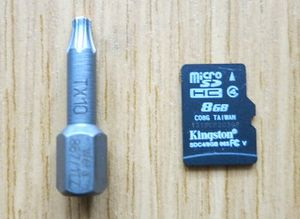Radarcape:EMMC Howto: Difference between revisions
imported>Beastadmin No edit summary |
imported>Beastadmin No edit summary |
||
| Line 1: | Line 1: | ||
{| | {| | ||
|[[File:Beginner.png|For Beginners]] | |[[File:Beginner.png|For Beginners]] | ||
|''Required computer skills to execute | |''Required computer skills to execute this task: Intermediate'' | ||
|} | |} | ||
Revision as of 19:19, 25 March 2015

|
Required computer skills to execute this task: Intermediate |
Scope
Beaglebone Black based devices of the Radarcape and FR24 box are working on an internal storage called eMMC while the elder Beaglebone White based units directly work with an SD card. In case of problems the contents of the eMMC can be restored with a recovery SD card. This can be done as often as you like, since the contents of the recovery SD card are not destroyed during the process.
Source of Recovery Data
Recovery Kit
If you have received such one, the recovery kit contains a Torx TX-10 screwdriver bit and a SD card.
Not necessarily the SD card is a 8GB and it will be labeled with the product to restore as well as probably with a version.
On request we can put recovery SD card images to our server so that you can make your own recovery SD card with a SD card writer.
Download SD Card Image
The recovery image can be downloaded from our server and be written to a standard SD card with WinDiskImager.
FR24 Receiver Recovery Image
The FR24 recovery image currently is not stored on the server.
Radarcape Recovery Image
- download RC-BBB-Angstrom-Writer.xz
- download the md5sum file RC-BBB-Angstrom-Writer.img.md5sum
- Perform a md5sum check before uncompressing and verify the integrity of the file.
- Uncompress the image with a xz uncompressing tool
The image currently is made for a 4GB Sandisk SD card and most probably will not fit to a 4GB Kingston card. However, flashing to a larger SD card seems to work fine.
- write the image to a SD card and then perform as below
Recovery Process
Unplug the unit from power
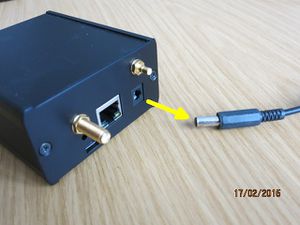
The other cables may be left connected or removed for convenience.
Open the front panel
Using a Torx TX10 screwdriver or the torx bit we've delivered open the two front panel screws. Due to machine tightening, it may be hard at the starting point. Don't use a drill and please don't use doubtful screwdriver.
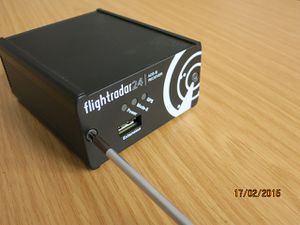
Set Boot Switch to SD Card Boot
There is a little slide switch on the top board. Shift this to the left hand position.
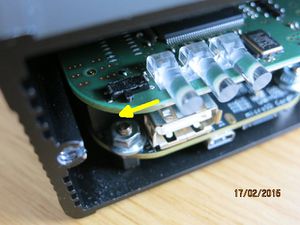
Insert the SD card
Insert the SD card. The label and text towards the upper side. Push in as far as it locks in the slot.
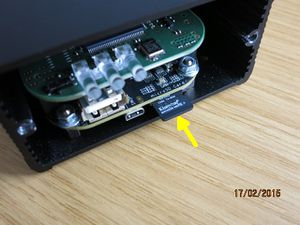
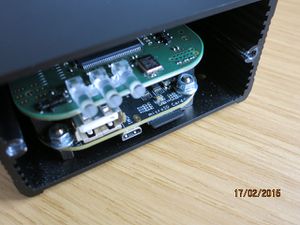
Apply power to the unit
Replug the power supply. You then should see the blue LEDs in the back flashing.
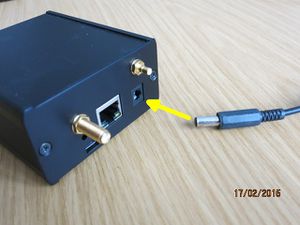
The recovery process takes about 1min for the Flightradar24 box and little longer for the Radarcape. If successful, the Radarcape/Flightradar24 receiver automatically powers off. All LEDs will be off then.
Remove SD Card
Remove the SD card.
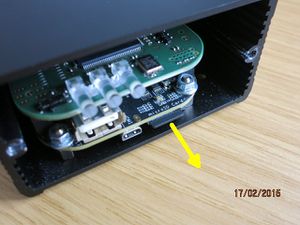
Reset Boot Switch to eMMC Boot
Reset the boot switch to eMMC boot.
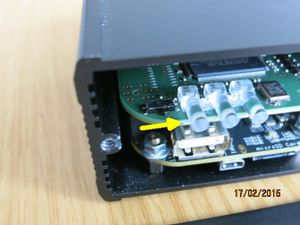
Finalisation
Finalize FR24 Recovery
First, plug your unit to the antenna and check that it is working, after you have verified this fix the front panel again and keep the recovery SD card in a safe place so that you can restore the system anytime again.
Finalize Radarcape Recovery
For a Radarcape, you addtitionally need to install the latest firmware package as it is shown in Radarcape:Firmware_Versions.
Mind that you have just two minutes for the whole process after power on because afterwards the hardware watchdog will trigger a reset. However, nothing can go wrong if this happens, and you anyway know how to to restore the whole Radarcape meanwhile.
- Prepare a ssh terminal, e.g. Putty (see other examples here in the Wiki if you need more details how to achieve this)
- Connect your Radarcape to the internet and after that to power.
- Wait around 15seconds until the unit is up or simply try to establish a connection
- Use the ssh terminal to open a console terminal to the destination radarcape (eventually you need radarcape.local). Your account name is root and there is no default password.
- copy the opkg install command from the latest release to your clipboard and paste it to the console. This starts the installation sequence.
You then will see how the SW installs and afterwards see the front panel LEDS coming back into operation.
By the way, this is exactly the process that is performed in our factory.
